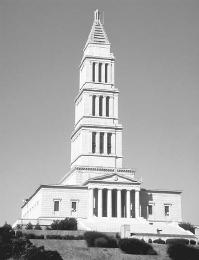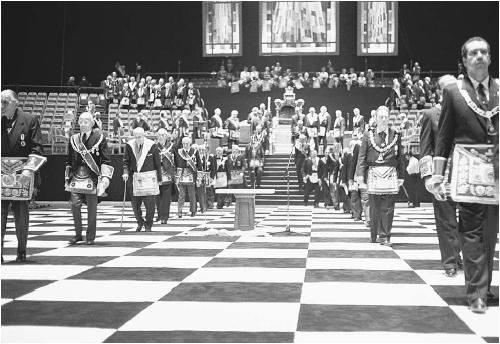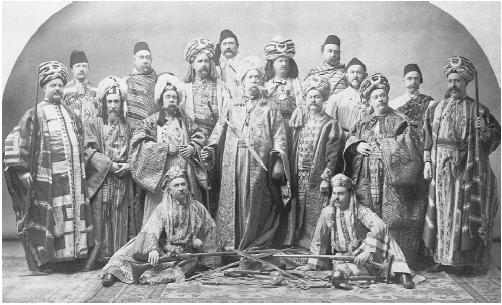THE FREEMASONS
There are those who claim that the Freemasons constitute a powerful secret brotherhood of darkness that is planning to take over the world. According to some scholars of the occult, the Masons' "Supreme Architect of the Universe" is none other than Lucifer, who cloaks himself in Masonic literature under such names as Zoraster, Shiva, Abaddon, and other pagan-god disguises. The so-called "holy writings" of Freemasonry, as well as their secret rites, passwords, initiations, and handshakes have their origins in the Roman mystery religions, Egyptian rituals, and Babylonian paganism. Often linked to the Illuminati, Freemasonry is said to have exerted its influence on every aspect of American society—including its currency.
Of all of the above alarmist concerns, only the part about the currency may have some credence. On the front of a one-dollar bill, there is a portrait of George Washington (1732–1799), an avowed Mason, who donned his Masonic apron and presided over the dedication of the United States Capitol. The flip side of the bill displays the Great Seal of the United States. The front side of the seal depicts the spread eagle, arrows in one claw, olive branch in the other, and a banner proclaiming E Pluribus Unum in its beak. Opposite the spread eagle, the backside of the seal, is an incomplete pyramid with an eye floating in a glowing triangle where the capstone should be. Above the eye is the caption Annuit Coeptis, commonly translated as "He has favored our undertaking," and in a scroll beneath is the slogan Novus Ordo Seclorum, "a new order of the ages."
Congress first authorized the creation of a Great Seal of the United States in 1792, but no real effort was made to have anyone design one. Nearly 100 years later, in 1884, Congress once again authorized the task of designing a Great Seal for the nation. In 1892, funds were allocated in the hope that an appropriate seal would be finished in time for the Chicago's World Fair. At last both sides of the seal were finally completed, but at its premiere showing, the side that featured the pyramid with the all-seeing eye was turned to the wall because some viewers were

Most scholars agree that the pyramid represented on the bill is the Great Pyramid of Cheops at Giza, which, to a Mason, is emblematic of the continuity of the craft of Freemasonry from the dawn of civilization in Egypt. For Freemasons it is also a reminder of the legend that Egyptian civilization was founded by survivors from Atlantis and that the United States is the New Atlantis foretold by the great master Mason Sir Francis Bacon (1561–1626). The pyramid with the all-seeing eye represents the Great Architect of the Universe that guided the Founding Fathers of the United States to establish a nation that might one day reveal itself as the heir of the ancient mysteries of Atlantis and restore all humankind to the earthly paradise that existed in that Golden Age of old.

The central mythos of Freemasonry centers around the building of the great temple of King Solomon (tenth century B.C.E.) and Solomon's securing the services of the most accomplished architect in the world, Hiram Abiff, who was said to have designed the magnificent temple according to the precepts of the Great Architect of the Universe. Although Hiram is mentioned in biblical accounts as a master of the arts of construction, the rites of Freemasonry extend beyond the Bible and fashion a parallel myth, portraying Hiram as a primary figure in the creation of the temple. According to Masonic tradition, the ancient builders of Solomon's Temple created the rites still practiced in modern lodges, with the various degrees of initiation and their secret symbols and handshakes.
While the Free and Accepted Order of Freemasons is the oldest fraternity in the world, it doesn't really extend back to the stone masons working on Solomon's Temple—nor does it date even farther back to those who labored on the Egyptian pyramids, as some Masons have claimed. Freemasonry did evolve from the guilds of the stonemasons who traveled from city to city in Europe of the fourteenth century looking for work on the great cathedrals being constructed at that time. The secret passwords and handshakes were unique ways by which a newcomer to a city might prove that he really was a true member of the guild. While there are references to Freemasonry as early as 1390, the fraternity did not come into being until 1717 when four London lodges united.
From its actual beginnings in the early 1700s, Freemasonry exerted a great deal of influence upon society. For one thing, in the midst of seemingly incessant quarreling over religion throughout the European nations, the Freemasons were nondenominational, asking only that its members recognized a Supreme Being and sought somehow to better humanity through the course of their own lives. Because men of low rank could become members and no religious philosophy was deemed

By the mid-1700s, Freemasonry had established its lodges throughout Europe and had been carried across the ocean to the New World by numerous immigrants. George Washington, Benjamin Franklin (1706– 1790), John Hancock (1737–1793), Paul Revere (1735–1818), and many other of the Founding Fathers of the United States were openly proud of being Masons. A freed slave, Prince Hall, who was initiated into Masonry by a British soldier in Boston, later founded an African lodge, which became the still-extant Prince Hall Masons.
After the Revolution (1775–83), American Freemasonry became extremely powerful in the United States. Lodges were constructed in the smallest of villages, and it became an undeniable sign of prestige in any community to be a member of the Masons. For businessmen who wished to succeed, it was almost a requirement to join the Freemasons.
At the same time, however, those individuals who were not privy to its secrets had begun to spread rumors about the bizarre rites and grim pledges that the members of the fraternity were sworn to uphold. Curiosity and concern that satanic rites might be held by supposedly upstanding businessmen who had sold their souls to the devil began to spread doubts about what was really going on behind the closed doors of its lodges. While the various oaths and rituals of the Masons would quite likely be judged as a bit overly dramatic and flamboyant by some, they were largely symbolic and representative of an earlier age—and far less dangerous to their initiates than many contemporary college fraternities or sororities.
It was the abducted and assumed tragic death of one of its members in 1826 that led to the near-annihilation of the Masons in the United States. William Morgan, a disillusioned Mason from Batavia, New York, let it be known that he was writing a book that would reveal all the secrets of Freemasonry to the world. The printer's shop that was going to publish his manuscript was torched, and a few days later, Morgan was arrested on charges that he was in arrears on a two-dollar debt. That night, a stranger arrived to pay Morgan's bail, and the dissident Mason was then seized by a group of his fellow lodge members and forced into a carriage. Neither Morgan nor his remains were ever found.
One of the cornerstones of Masonry was its loyalty to its members, but the entire nation was offended by the manner in which the juries were stacked in favor of those Masons who were accused of having murdered William Morgan. The general population demanded justice, and they were shocked by the power of a secret society that could stonewall three special prosecutors. After 20 trials for murder and kidnapping, the local sheriff, who was a Mason, and who was obviously an integral element in Morgan's abduction and disappearance, received the most severe judgment of all the defendants when he was sentenced to 30 months in jail.
Not only did an anti-Mason sentiment swell within the country, but the Anti-Mason Party was founded that elected governors in Pennsylvania and Vermont and won seven electoral votes in the 1832 election. It was no longer prestigious to be a Mason. In state after state, lodges closed. Overall, the fraternity lost more than half of its members.
By 1845, Freemasonry began to revive in the United States, but it never again achieved the social status that it had once enjoyed. In 1872, two Masons formed a kind of parody of the Masons and named it the Ancient Arabic Order of the Nobles of the Mystic Shrine, aka, The Shriners. By 1897, the Masons had about 750,000 members, and numerous other fraternal organizations such as the Knights of Columbus, the Benevolent and Protective Order of Elks, the Odd Fellows, and the Loyal Order of Moose sprang into being. In the 1950s, the Masons reached their numerical peak in America with more than four million members.
In 2001, there were about two million Masons in the United States and their average age was well over 60. Younger men, it seems, are no longer attracted to an organization whose members receive such grandiose titles as Master of the Royal Secret, Knight of the Brazen Serpent, or Worshipful Master. As for being a secret society, Masonic Lodge telephone numbers are in the directory, and the texts of many of their oaths have been made public, i.e., "You agree to be a good man and true; you agree to conform to the laws of the country in which you reside; you promise not to be concerned in plots and conspiracies against the government."
DELVING DEEPER
Carlson, Peter. "Fezzes, Sphinxes and Secret Handshakes," The Washington Post, November 25, 2001 [Online] http://www.washingtonpost.com/wp-dyn/articles/A61372-2001Nov20.html.
Goeringer, Conrad. "Freemasons—From the 700 Club to Art Bell, an Object of Conspiracy Thinking." American Atheist, May 1998 [Online] http://www.americanatheist.org/supplement/conspiracy.html.
Lomas, Robert, and Christopher Knight. The Hiram Key: Pharaohs, Freemasons, and the Discovery of the Secret Scrolls of Jesus. Boston: Element Books, 1999.
MaCoy, Robert. A Dictionary of Freemasonry. New York: Gramercy Books, 2000.
Seligmann, Kurt. The History of Magic. New York: Pantheon Books, 1948.

Comment about this article, ask questions, or add new information about this topic: